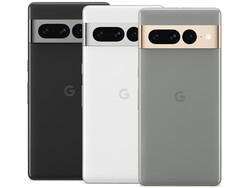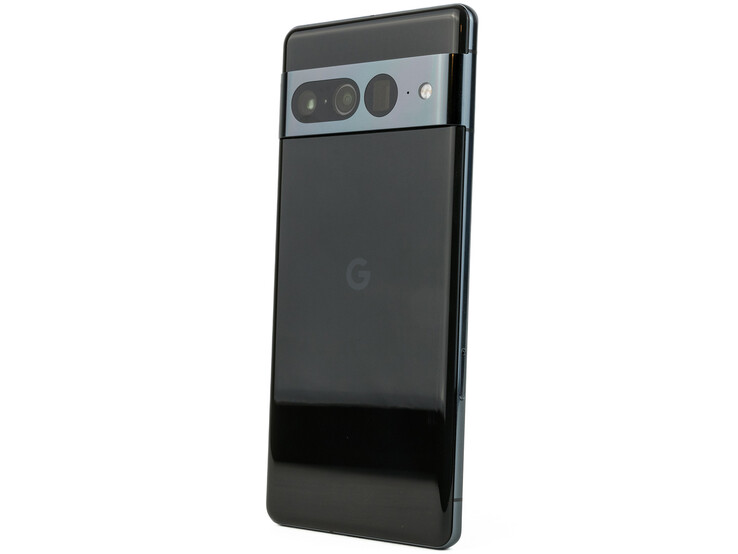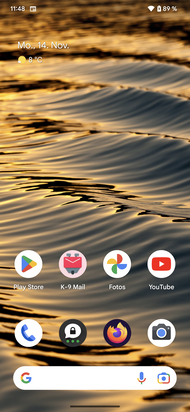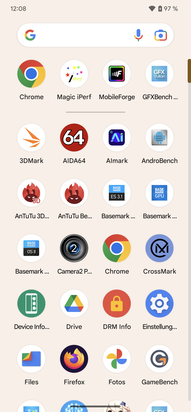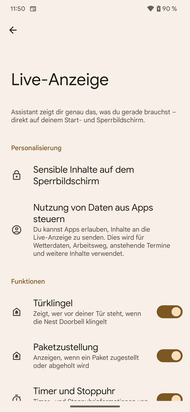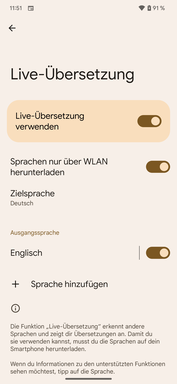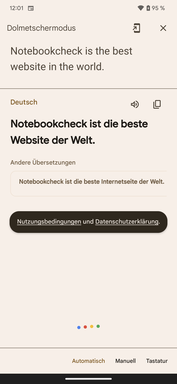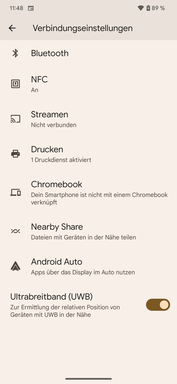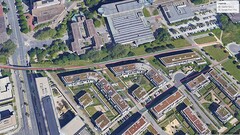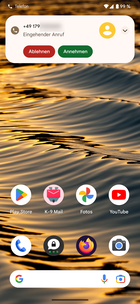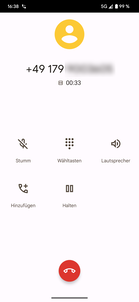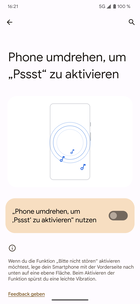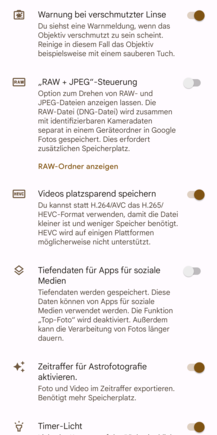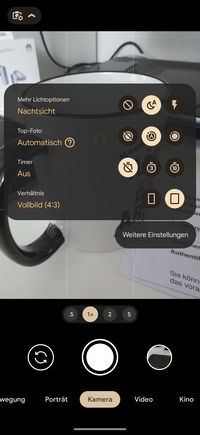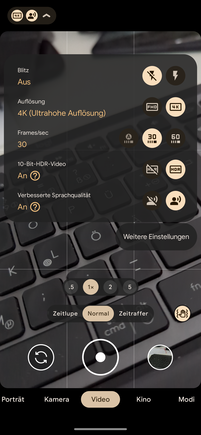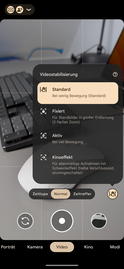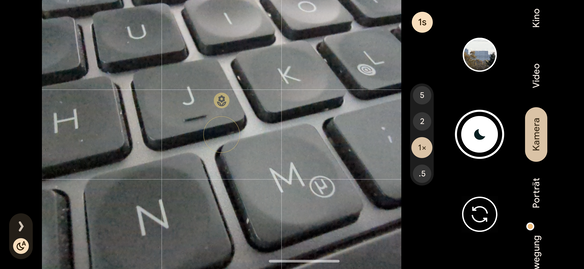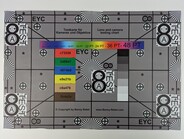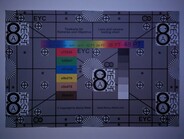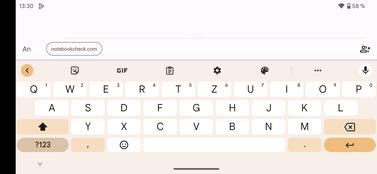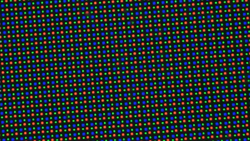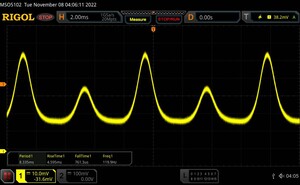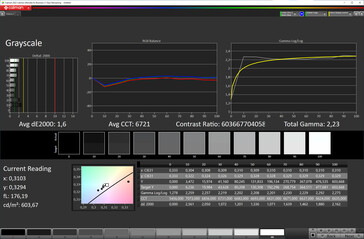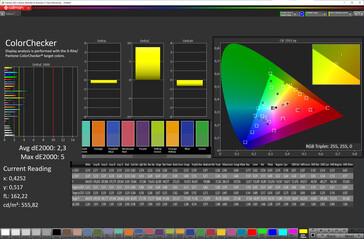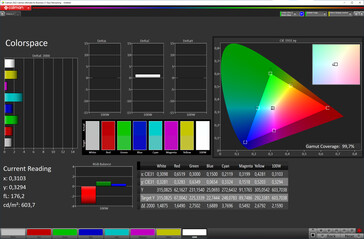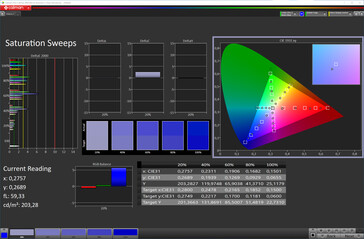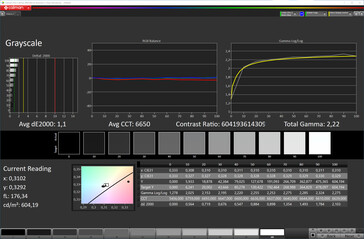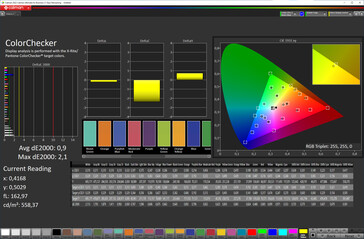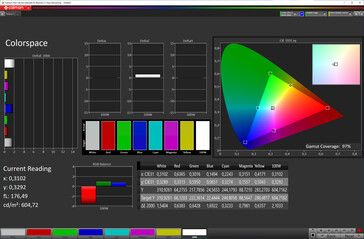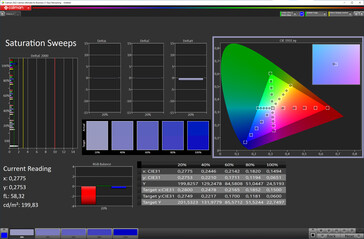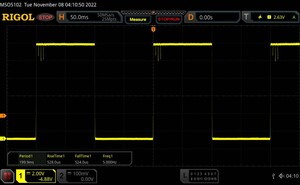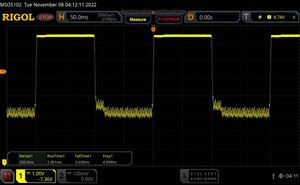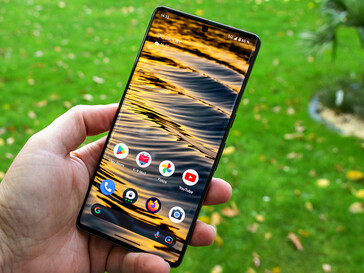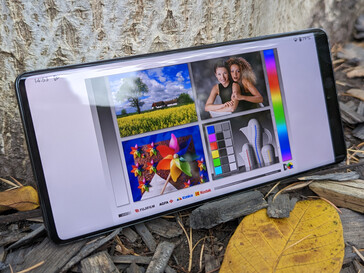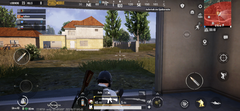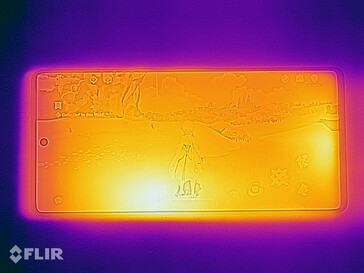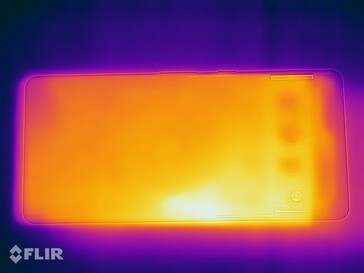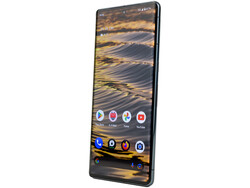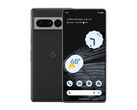Google Pixel 7 Pro review: Premium smartphone with stock Android
Google only just recently presented its mid-range offspring, the Pixel 6a, and now the company is following up with the new Pixel 7 series. The Pixel 7 Pro under review here is the direct successor to the Pixel 6 Pro and essentially sticks to a proven design, but comes with an improved camera setup and a newer SoC.
The predecessor had to endure criticism from end users for yellowish displays, weak reception and a sluggish fingerprint sensor, which is why we pay special attention to these issues in the following review.
On the bright side, prices have remained stable this year and the Pixel 7 Pro starts at around US$899 for the 128 GB variant, with the upgrade to 256GB costing an additional US$100. The 512 GB model (US$1,300) can only be purchased in the US thus far. This year, all storage versions are also finally available for all color options.
Possible Competitors in Comparison
Rating | Date | Model | Weight | Drive | Size | Resolution | Price |
|---|---|---|---|---|---|---|---|
| 89.1 % v7 (old) | 11 / 2022 | Google Pixel 7 Pro Tensor G2, Mali-G710 MP7 | 212 g | 128 GB UFS 3.1 Flash | 6.70" | 3120x1440 | |
| 90.3 % v7 (old) | 03 / 2023 | Apple iPhone 14 Pro Max A16, A16 GPU 5-Core | 240 g | 128 GB NVMe | 6.70" | 2796x1290 | |
| 89.3 % v7 (old) | 10 / 2022 | Motorola Edge 30 Ultra SD 8+ Gen 1, Adreno 730 | 198.5 g | 256 GB UFS 3.1 Flash | 6.67" | 2400x1080 | |
| 87.7 % v7 (old) | 11 / 2022 | Xiaomi 12T Pro 5G SD 8+ Gen 1, Adreno 730 | 205 g | 256 GB UFS 3.1 Flash | 6.67" | 2712x1220 | |
| 88.9 % v7 (old) | 05 / 2022 | Samsung Galaxy S22+ Exynos 2200, Xclipse 920 | 196 g | 128 GB UFS 3.1 Flash | 6.60" | 2340x1080 | |
| 87 % v7 (old) | 08 / 2022 | OnePlus 10T SD 8+ Gen 1, Adreno 730 | 203.5 g | 256 GB UFS 3.1 Flash | 6.70" | 2412x1080 | |
| 89.2 % v7 (old) | 12 / 2022 | Sony Xperia 5 IV SD 8 Gen 1, Adreno 730 | 171 g | 128 GB UFS 3.1 Flash | 6.10" | 2520x1080 | |
| 89.2 % v7 (old) | 04 / 2022 | Google Pixel 6 Pro Tensor, Mali-G78 MP20 | 210 g | 128 GB UFS 3.1 Flash | 6.70" | 3120x1440 |
Case - Stylish look and Gorilla Glass Victus
The Pixel 7 Pro has the same striking design as its predecessor, but the camera hump now merges seamlessly into the case frame, which looks even more high quality. The manufacturer specifies the thickness as 8.9 millimeters; we measured 8.55 millimeters without the camera. Including the camera, the Pixel smartphone measures 11.1 millimeters.
Both the front and the back are protected by Corning Gorilla Glass Victus, which has a very pleasing feel and is also visually convincing. Unfortunately, it is also extremely susceptible to fingerprints. Because of the smooth glass surface, users need to watch out for the smartphone on slightly uneven surfaces due to the danger of it slipping away.
The build quality is solid and is characterized by narrow and even gaps. Torsional rigidity is also high, and we were unable to elicit the slightest noise from the Pixel 7 Pro in the corresponding tests. The SIM slot's cover is almost flush with the frame and can accommodate a nano-SIM.
The Pixel 7 Pro is available in Hazel (gray), Snow (white) and Obsidian (black). The battery is permanently installed and the smartphone is dust- and waterproof according to IP68.
Equipment - USB 3.2 (Gen. 2) and UWB for the Pixel 7 Pro
Google has given the Pixel 7 Pro a fast 2nd generation USB 3.2 port that works with a data transfer rate of up to 10 GBit/s and supports wired image output. Apart from the Pixel 7, only the ROG Phone 6 offers such a powerful connection.
It should be borne in mind that there is no microSD support when selecting the storage. An IR blaster, an audio jack or a notification LED have not been installed either. The recess in the frame at the top of the Google smartphone is intended for the 5G mmWave antennas, but this mobile standard is not yet available in Europe. Google does not reveal whether the antennas have been installed nonetheless and whether they will be activated later via an update.
In addition to Bluetooth 5.2, Wi-Fi 6E and NFC, the Pixel 7 Pro also supports UWB.
Software - Fast Google updates until 2027
The Google Pixel 7 Pro comes with stock Android 13 and the latest security patches, which are updated monthly. At least three version upgrades and two more years of security updates will be provided (until October 2027). So this means that the smartphone will get Android 16 at the very least; Google reveals the corresponding details on an FAQ page.
In addition to the well-known Pixel features, Google is now providing its own VPN solution for Pixel owners. However, the feature was not available at the time of review and is expected to be added via an update in December 2022.
The smartphone can now translate 48 languages via live translations. This includes written texts in messengers, text captured via the camera, subtitles in videos, and even live translations for speech in some languages. The latter can be launched via Google Assistant with the command "Be my interpreter" and works surprisingly well.
Google preinstalls most of its own apps, but refrains from installing third-party applications.
Communication & GNSS - Pixel 7 Pro with 5G Sub6 and Wi-Fi 6E
On paper, the Google Pixel 7 Pro is Wi-Fi 6E capable. Unfortunately, the Google smartphone does not recognize the 6 GHz band of our Asus ROG Rapture GT-AXE11000 reference router. This is likely to be amended via a future update. As soon as this is the case, we will provide the corresponding test results. On the 5 GHz network, performance values are very promising and very good in terms of both speed and stability.
In Europe, the Pixel 7 Pro only supports 5G Sub6, which isn't much of an issue currently due to the lack of mmWave networks, but will certainly become more important in the near future. The signal qualities of the Pixel 6 (Pro) were a frequent point of criticism. The Pixel 7 Pro, in contrast, makes a strong impression in metropolitan areas (network: Telekom, 5G) and leaves no room for criticism. In direct comparison to the iPhone 14 Pro Max and the Motorola Edge 30 Ultra, the attenuation (loss of signal) within the same radio cell is slightly higher, but the data transfer performance is at a similar level. So there is no noticeable difference in this scenario.
The Pixel 7 Pro supports a large number of frequency bands, so it should be usable all over the world.
| Networking | |
| Google Pixel 7 Pro | |
| iperf3 receive AXE11000 | |
| iperf3 transmit AXE11000 | |
| iperf3 transmit AXE11000 6GHz | |
| iperf3 receive AXE11000 6GHz | |
| Apple iPhone 14 Pro Max | |
| iperf3 receive AXE11000 | |
| iperf3 transmit AXE11000 | |
| Motorola Edge 30 Ultra | |
| iperf3 receive AXE11000 | |
| iperf3 transmit AXE11000 | |
| iperf3 transmit AXE11000 6GHz | |
| iperf3 receive AXE11000 6GHz | |
| Xiaomi 12T Pro 5G | |
| iperf3 receive AXE11000 | |
| iperf3 transmit AXE11000 | |
| Samsung Galaxy S22+ | |
| iperf3 receive AXE11000 | |
| iperf3 transmit AXE11000 | |
| iperf3 transmit AXE11000 6GHz | |
| iperf3 receive AXE11000 6GHz | |
| OnePlus 10T | |
| iperf3 receive AXE11000 | |
| iperf3 transmit AXE11000 | |
| Sony Xperia 5 IV | |
| iperf3 receive AXE11000 | |
| iperf3 transmit AXE11000 | |
| iperf3 transmit AXE11000 6GHz | |
| iperf3 receive AXE11000 6GHz | |
| Google Pixel 6 Pro | |
| iperf3 receive AXE11000 | |
| iperf3 transmit AXE11000 | |
| Average of class Smartphone | |
| iperf3 receive AXE11000 | |
| iperf3 transmit AXE11000 | |
| iperf3 transmit AXE11000 6GHz | |
| iperf3 receive AXE11000 6GHz | |
For localization, the Google Pixel 7 Pro uses dual-band GNSS to connect to the GPS, Glonass, Galileo, QZSS and BeiDou satellite networks. Sattelite positioning is very fast and accurate outdoors, but takes longer indoors and the smartphone needs some time before displaying suitable levels of accuracy.
We compared the Pixel with the Garmin Venu 2 fitness smartwatch on a short bike tour. Its tracking capabilities are quite decent, but not as accurate as the Garmin watch. Nevertheless, the performance offered is absolutely satisfactory for navigational tasks.
Telephony & Voice Quality
The Google Pixel 7 Pro is a dual-SIM smartphone that offers room for a physical nano-SIM and an eSIM. In March 2023, dual eSIM support will be provided via an update. Features such as VoLTE and WLAN calling are supported, but Google has disabled Android's built-in SIP account controls.
We were very satisfied with the voice quality in our tests. When held to the ear, the Pixel smartphone reproduces the user's voice very naturally, although the better microphones make it sound slightly duller than usual. But this is not noticeable in everyday use. Minor background noises are inaudible and filtered out without any loss of quality. The Pixel even copes satisfactorily in noisy environments, such as a busy café, although background noise occasionally slips through and the user's voice sounds a little hollow. The latter effect only becomes more audible in very loud environments, but even then the Pixel 7 Pro does its job really well.
The proximity sensor is located in the panel and reacts very quickly and reliably. However, it has the disadvantage that the screen is dimmed during a call, which does not help when we want to access the quick menu.
A lot of fine-tuning for the cameras of the Pixel 7 Pro
The front camera of the Google Pixel 7 Pro works with a resolution similar to that of the predecessor, delivering 10.8 MP. Unfortunately, it only uses a fixed focus. Videos can be recorded in Ultra HD at up to 60 FPS, but those wanting to use HDR will be limited to 30 FPS. Google also offers an automatic night mode and the "Top Shot" function for photography on the front. In the case of the latter, the smartphone records a short video and makes a selection of photos from which the user can choose the appropriate one. In addition, a two-stage face retouching can be activated. An extended wide-angle option is also available for group selfies. Overall, we like the photos with the front camera. Only in backlight do the pictures appear a little pale.
The camera setup on the back is also very similar to that of the Pixel 6 Pro. The main camera uses a 50 MP sensor from Samsung, which is supplemented by an ultra-wide-angle at 12 MP and a 48 MP telephoto lens that promises fivefold (5x) optical magnification. In comparison, the predecessor had fourfold (x4) optical zoom and the ultra-wide angle only had an angle of 114 degrees (Pixel 7 Pro: 125.8 degrees).
The main camera takes really good photos and strikes a good balance in regard to sharpness. This is especially true of close-ups, while image quality is a little weaker in panoramic shots, especially when backlit. Although the dynamic range is high across the entire image, there are some weaknesses in the details. Contours are slightly muddy and washed out. The night mode also produced a few errors in our tests and, among other things, our droid appeared strangely dirty. Google will certainly make improvements here, especially since the low-light performance is otherwise very good.
The optical zoom does its job very well in daylight and can digitally enlarge up to a factor of 30. This strong zoom is no longer suitable for prints, but is quite useful for zooming in on a sign, poster or something similar from a distance. The optical viewfinder in the live view, which is activated at a magnification of 15x, is also practical. Image stabilization is good, but it does not capture movement or moving subjects as well as, for example, Samsung's Galaxy S22 Ultra or Vivo's X80 Pro.
Despite the now comparatively low resolution, the ultra-wide-angle lens take good photos, even if it cannot keep up with the main camera. Slight aberrations can occur in the peripheral areas, especially where hard edges (i.e. of buildings) are present, and shot noise is greater in these areas. A macro lens is also available. The Pixel 7 Pro switches to macro mode rather quickly early on, but this can be deactivated via a small button.
In terms of videography, Google's smartphone delivers good results, but it cannot keep up with other top smartphones in terms of functionality. The missing 8k mode is certainly the easiest loss to bear, but there is also no choice of aspect ratios whatsoever, and the refresh rates are limited to 30 and 60 FPS. We like the option of being able to record 10-bit HDR videos, although this is limited to Ultra HD at 30 FPS. The slow motion function is only available in Full HD, while the time-lapse is available in 4k for all lenses.
Image comparison
Choose a scene and navigate within the first image. One click changes the position on touchscreens. One click on the zoomed-in image opens the original in a new window. The first image shows the scaled photograph of the test device.
Main cameraMain cameraUltra wide angle5x zoomLow lightUnder controlled lighting conditions, the Google Pixel 7 Pro delivers good image quality. The test chart is captured with a fairly warm white balance, but details remain very clear up to the peripheral area. Subjects appear bright and well-lit in low light (1 lux), but the image is then very cool and correspondingly bluish.
Color reproduction is also very good. Only cyan is a little off target with a slightly increased deviation from DeltaE.
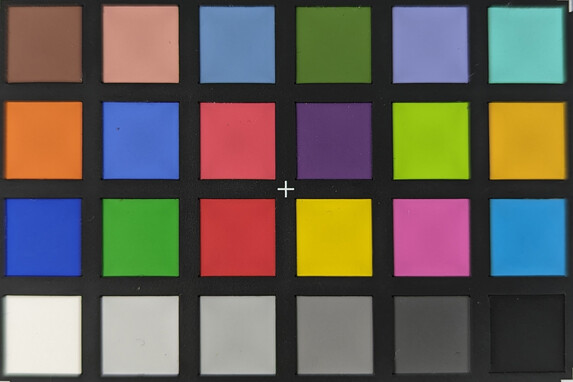
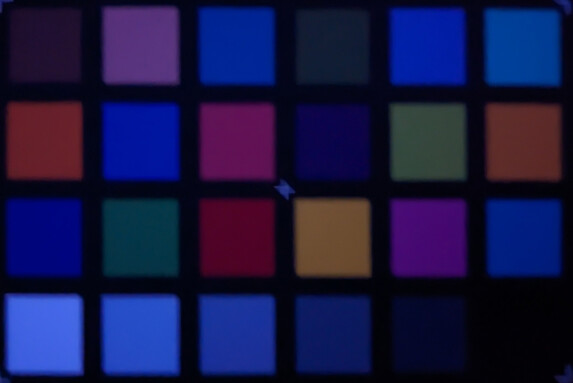
Accessories & Warranty - Narrow scope of delivery
The Google Pixel 7 Pro only comes with a USB-C cable and an OTG adapter (Type-C to Type-A). Those wanting a matching power adapter directly from Google have to shell out an additional US$30, and the wireless charging station costs around US$80. In addition, Google also offers protective cases for its smartphone, which are available from around US$22.
The warranty is 24 months in Germany and cannot be extended. This may differ in other regions, so be sure to check with your supplier before purchasing.
Input Devices & Operation - Pixel 7 Pro now with facial recognition
The capacitive touchscreen of the Pixel 7 Pro recognizes up to ten touches simultaneously and is protected by Corning Gorilla Glass Victus. Gliding properties are excellent, especially since Google does not use a protective film. The physical keys sit firmly in the frame and have a short travel.
Google once again installs an optical fingerprint scanner for biometric security. Although this works more reliably than in the Pixel 6 Pro, the contact area remains very small, so that it is easy to misplace the finger. The Vixo X80 Pro is in a different league in this regard, since it uses a large ultrasonic sensor. At least facial recognition is now also on board. This functioned very quickly and reliably under testing, but it should be noted that this is a less secure unlocking method.
The vibration motor delivers both crisp and haptically appealing feedback. Some useful operating aids have also been integrated into the Pixel 7 Pro. For example, a preset action can be triggered by double tapping the back of the smartphone. This could be, for example, turning the flashlight on or off or taking a screenshot. Starting specially selected apps directly is also possible.
Display - Bright LTPO OLED up to 120 Hz
The display of the Google Pixel 7 Pro measures 6.7 inches (17.02 cm) and optionally offers QHD+ resolution (3,120 x 1,440), but Full HD+ with a lower pixel density is preset. According to the specifications, the OLED panel is capable of LTPO, which means that the system should automatically vary the refresh rate between 10 and 120 Hz. Unfortunately, this was not confirmed in our tests because the smartphone only switches between 60 and 120 Hz when Smooth Display is activated. The Pixel 7 Pro supports the most common HDR standards (HLG, HDR10, HDR10+). An always-on function is available, but can only be configured to a very limited extent.
The panel brightness reaches an average of a very high 1025 cd/m² in a pure white display with the ambient light sensor activated and is extremely uniform. With a even distribution of bright and dark areas (APL18), the display reaches up to 1,499 cd/m². If you do not use the sensor for control, a maximum of 585 cd/m² is available.
We determined OLED flickering in our measurements with the oscilloscope, but this is very constant at low brightness and is on par with the refresh rate at 120 Hz. As the display gets brighter, the frequency jumps to a stable 240 Hz. The effect is comparable to permanent DC dimming, which is why the likelihood of complaints is lower than with displays that have a choppier progression.
We did not observe any temporal dithering. For this, we examined the display through a microscope during the playback of a 240 FPS slow motion video (dark gray, at full brightness).
| |||||||||||||||||||||||||
Brightness Distribution: 99 %
Center on Battery: 1022 cd/m²
Contrast: ∞:1 (Black: 0 cd/m²)
ΔE ColorChecker Calman: 0.9 | ∀{0.5-29.43 Ø4.82}
ΔE Greyscale Calman: 1.1 | ∀{0.09-98 Ø5.1}
97% sRGB (Calman 2D)
Gamma: 2.22
CCT: 6650 K
| Google Pixel 7 Pro OLED, 3120x1440, 6.7" | Apple iPhone 14 Pro Max Super Retina XDR OLED, 2796x1290, 6.7" | Motorola Edge 30 Ultra pOLED, 2400x1080, 6.7" | Xiaomi 12T Pro 5G AMOLED, 2712x1220, 6.7" | Samsung Galaxy S22+ AMOLED, 2340x1080, 6.6" | OnePlus 10T Fluid AMOLED, 2412x1080, 6.7" | Sony Xperia 5 IV OLED, 2520x1080, 6.1" | Google Pixel 6 Pro LTPO-OLED, 3120x1440, 6.7" | |
|---|---|---|---|---|---|---|---|---|
| Screen | -22% | -23% | -19% | -59% | -75% | -62% | -15% | |
| Brightness middle | 1022 | 1061 4% | 1020 0% | 913 -11% | 1090 7% | 861 -16% | 896 -12% | 794 -22% |
| Brightness | 1025 | 1057 3% | 1020 0% | 913 -11% | 1097 7% | 856 -16% | 902 -12% | 801 -22% |
| Brightness Distribution | 99 | 99 0% | 96 -3% | 95 -4% | 98 -1% | 97 -2% | 97 -2% | 97 -2% |
| Black Level * | ||||||||
| Colorchecker dE 2000 * | 0.9 | 1.3 -44% | 1 -11% | 1 -11% | 2.5 -178% | 2.27 -152% | 2 -122% | 0.9 -0% |
| Colorchecker dE 2000 max. * | 2.1 | 3.1 -48% | 2.8 -33% | 2.4 -14% | 3.8 -81% | 4.17 -99% | 6.4 -205% | 2.2 -5% |
| Greyscale dE 2000 * | 1.1 | 1.6 -45% | 2.1 -91% | 1.8 -64% | 2.3 -109% | 2.9 -164% | 1.3 -18% | 1.5 -36% |
| Gamma | 2.22 99% | 2.19 100% | 2.29 96% | 2.23 99% | 2.04 108% | 2.303 96% | 2.25 98% | 2.23 99% |
| CCT | 6650 98% | 6511 100% | 6502 100% | 6273 104% | 6492 100% | 6141 106% | 6618 98% | 6654 98% |
* ... smaller is better
Screen Flickering / PWM (Pulse-Width Modulation)
| Screen flickering / PWM detected | 240 Hz | ||
The display backlight flickers at 240 Hz (worst case, e.g., utilizing PWM) . The frequency of 240 Hz is relatively low, so sensitive users will likely notice flickering and experience eyestrain at the stated brightness setting and below. In comparison: 53 % of all tested devices do not use PWM to dim the display. If PWM was detected, an average of 8320 (minimum: 5 - maximum: 343500) Hz was measured. | |||
Series of measurements at a fixed zoom level and different brightness settings
We examined color representation using a photospectrometer and CalMAN analysis software. The preset color profile Adaptive offers a slightly more saturated display and uses an extended sRGB color space. As the name suggests, imaging performance is more accurate under the profile Natural. All in all, the Pixel 7 Pro does everything right in this area and delivers impeccable imaging performance.
Display Response Times
| ↔ Response Time Black to White | ||
|---|---|---|
| 1.05 ms ... rise ↗ and fall ↘ combined | ↗ 0.528 ms rise | |
| ↘ 0.524 ms fall | ||
| The screen shows very fast response rates in our tests and should be very well suited for fast-paced gaming. In comparison, all tested devices range from 0.1 (minimum) to 240 (maximum) ms. » 3 % of all devices are better. This means that the measured response time is better than the average of all tested devices (20.5 ms). | ||
| ↔ Response Time 50% Grey to 80% Grey | ||
| 6.01 ms ... rise ↗ and fall ↘ combined | ↗ 2.981 ms rise | |
| ↘ 3.028 ms fall | ||
| The screen shows very fast response rates in our tests and should be very well suited for fast-paced gaming. In comparison, all tested devices range from 0.165 (minimum) to 636 (maximum) ms. » 17 % of all devices are better. This means that the measured response time is better than the average of all tested devices (32 ms). | ||
Performance: Google Tensor G2 with slight performance increase
Google uses the second generation of its own ARM processor, manufactured by Samsung, for the Pixel 7 Pro. Compared with the first-generation Tensor, the Google Tensor G2 uses a very similar CPU, which again consists of three clusters. These comprise two powerful Cortex X1 cores, which run up to 2.85 GHz, two Cortex A78 (up to 2.35 GHz each) and four energy-saving Cortex A55 cores (up to 1.8 GHz). This means that the maximum clock is just 50 MHz higher.
The single-core test in Geekbench thus reveals only a minimal increase in performance. But this is slightly higher when all cores are utilized, thanks to the more modern A78 cores. However, the Tensor G2 falls behind other high-end processors and is even forced to concede defeat to the Exynos 2200.
The increases in AI performance are much higher. In Procyon, we recorded an increase of a whopping 53 percent compared to the predecessor, but this still ranks well behind the Snapdragon 8+ Gen 1 in the Xiaomi 12T Pro.
Nevertheless, this does not detract from the excellent system speed of the Pixel 7 Pro. In everyday use, the Google smartphone is as smooth as butter.
| UL Procyon AI Inference for Android - Overall Score NNAPI | |
| Sony Xperia 5 IV | |
| Xiaomi 12T Pro 5G | |
| Google Pixel 7 Pro | |
| Average Google Tensor G2 (37656 - 44323, n=5) | |
| Google Pixel 6 Pro | |
| Average of class Smartphone (3769 - 81594, n=140, last 2 years) | |
| Motorola Edge 30 Ultra | |
| OnePlus 10T | |
| Geekbench ML | |
| 0.5 TensorFlow Lite CPU 0.5 | |
| Apple iPhone 14 Pro Max | |
| Average of class Smartphone (381 - 1418, n=4, last 2 years) | |
| Motorola Edge 30 Ultra | |
| Google Pixel 7 Pro | |
| Average Google Tensor G2 (n=1) | |
| 0.5 TensorFlow Lite GPU | |
| Apple iPhone 14 Pro Max | |
| Motorola Edge 30 Ultra | |
| Average of class Smartphone (1058 - 2842, n=4, last 2 years) | |
| Google Pixel 7 Pro | |
| Average Google Tensor G2 (n=1) | |
| 0.5 TensorFlow Lite NNAPI / Core ML | |
| Apple iPhone 14 Pro Max | |
| Average of class Smartphone (344 - 3638, n=4, last 2 years) | |
| Google Pixel 7 Pro | |
| Average Google Tensor G2 (n=1) | |
| Motorola Edge 30 Ultra | |
For graphics acceleration, the Google Pixel 7 Pro uses an ARM Mali-G710 MP7, integrated into the SoC, which is the weakest GPU from this series to date. The more powerful G710 MP10 is used in the ROG Phone 6D, for example. Even a variant with up to 16 cores would be possible on ARM's part.
In terms of performance, the diagnosis is mixed. If the older OpenGL ES API is used, the Pixel smartphone is able to double its performance in some places. Unfortunately, the situation is different with the modern Vulkan API, where increases are only in the low single-digit percentage range. While performance is still very high, it offers less reserves in view of the smartphone's long lifespan.
GFXBench (DX / GLBenchmark) 2.7: T-Rex Onscreen | 1920x1080 T-Rex Offscreen
GFXBench 3.0: on screen Manhattan Onscreen OGL | 1920x1080 1080p Manhattan Offscreen
GFXBench 3.1: on screen Manhattan ES 3.1 Onscreen | 1920x1080 Manhattan ES 3.1 Offscreen
GFXBench: on screen Car Chase Onscreen | 1920x1080 Car Chase Offscreen | on screen Aztec Ruins High Tier Onscreen | 2560x1440 Aztec Ruins High Tier Offscreen | on screen Aztec Ruins Normal Tier Onscreen | 1920x1080 Aztec Ruins Normal Tier Offscreen
| 3DMark / Wild Life Extreme Unlimited | |
| Apple iPhone 14 Pro Max | |
| OnePlus 10T | |
| Motorola Edge 30 Ultra | |
| Xiaomi 12T Pro 5G | |
| Sony Xperia 5 IV | |
| Google Pixel 6 Pro | |
| Samsung Galaxy S22+ | |
| Google Pixel 7 Pro | |
| 3DMark / Wild Life Extreme | |
| Apple iPhone 14 Pro Max | |
| OnePlus 10T | |
| Motorola Edge 30 Ultra | |
| Xiaomi 12T Pro 5G | |
| Sony Xperia 5 IV | |
| Samsung Galaxy S22+ | |
| Google Pixel 6 Pro | |
| Google Pixel 7 Pro | |
| 3DMark / Wild Life Unlimited Score | |
| Apple iPhone 14 Pro Max | |
| Xiaomi 12T Pro 5G | |
| OnePlus 10T | |
| Motorola Edge 30 Ultra | |
| Sony Xperia 5 IV | |
| Samsung Galaxy S22+ | |
| Google Pixel 6 Pro | |
| Google Pixel 7 Pro | |
| 3DMark / Sling Shot Extreme (Vulkan) Unlimited Physics | |
| Samsung Galaxy S22+ | |
| 3DMark / Sling Shot Extreme (Vulkan) Unlimited Graphics | |
| Samsung Galaxy S22+ | |
| 3DMark / Sling Shot Extreme (Vulkan) Unlimited | |
| Samsung Galaxy S22+ | |
| 3DMark / Sling Shot Extreme (ES 3.1) Unlimited Physics | |
| Motorola Edge 30 Ultra | |
| Xiaomi 12T Pro 5G | |
| Google Pixel 7 Pro | |
| Sony Xperia 5 IV | |
| Google Pixel 6 Pro | |
| Samsung Galaxy S22+ | |
| OnePlus 10T | |
| 3DMark / Sling Shot Extreme (ES 3.1) Unlimited Graphics | |
| Motorola Edge 30 Ultra | |
| Xiaomi 12T Pro 5G | |
| OnePlus 10T | |
| Sony Xperia 5 IV | |
| Samsung Galaxy S22+ | |
| Google Pixel 7 Pro | |
| Google Pixel 6 Pro | |
| 3DMark / Sling Shot Extreme (ES 3.1) Unlimited | |
| Motorola Edge 30 Ultra | |
| Xiaomi 12T Pro 5G | |
| Sony Xperia 5 IV | |
| OnePlus 10T | |
| Samsung Galaxy S22+ | |
| Google Pixel 7 Pro | |
| Google Pixel 6 Pro | |
| GFXBench (DX / GLBenchmark) 2.7 / T-Rex Onscreen | |
| Motorola Edge 30 Ultra | |
| Google Pixel 7 Pro | |
| Xiaomi 12T Pro 5G | |
| Samsung Galaxy S22+ | |
| Google Pixel 6 Pro | |
| Sony Xperia 5 IV | |
| OnePlus 10T | |
| Apple iPhone 14 Pro Max | |
| GFXBench (DX / GLBenchmark) 2.7 / T-Rex Offscreen | |
| Xiaomi 12T Pro 5G | |
| Motorola Edge 30 Ultra | |
| Apple iPhone 14 Pro Max | |
| OnePlus 10T | |
| Samsung Galaxy S22+ | |
| Sony Xperia 5 IV | |
| Google Pixel 7 Pro | |
| Google Pixel 6 Pro | |
| GFXBench 3.0 / Manhattan Onscreen OGL | |
| Motorola Edge 30 Ultra | |
| Xiaomi 12T Pro 5G | |
| Samsung Galaxy S22+ | |
| Google Pixel 7 Pro | |
| Google Pixel 6 Pro | |
| OnePlus 10T | |
| Apple iPhone 14 Pro Max | |
| Sony Xperia 5 IV | |
| GFXBench 3.0 / 1080p Manhattan Offscreen | |
| Apple iPhone 14 Pro Max | |
| Xiaomi 12T Pro 5G | |
| Motorola Edge 30 Ultra | |
| OnePlus 10T | |
| Samsung Galaxy S22+ | |
| Sony Xperia 5 IV | |
| Google Pixel 7 Pro | |
| Google Pixel 6 Pro | |
| GFXBench 3.1 / Manhattan ES 3.1 Onscreen | |
| Motorola Edge 30 Ultra | |
| Xiaomi 12T Pro 5G | |
| Samsung Galaxy S22+ | |
| OnePlus 10T | |
| Apple iPhone 14 Pro Max | |
| Sony Xperia 5 IV | |
| Google Pixel 7 Pro | |
| Google Pixel 6 Pro | |
| GFXBench 3.1 / Manhattan ES 3.1 Offscreen | |
| Apple iPhone 14 Pro Max | |
| Xiaomi 12T Pro 5G | |
| Motorola Edge 30 Ultra | |
| OnePlus 10T | |
| Samsung Galaxy S22+ | |
| Sony Xperia 5 IV | |
| Google Pixel 7 Pro | |
| Google Pixel 6 Pro | |
| GFXBench / Car Chase Onscreen | |
| Motorola Edge 30 Ultra | |
| Xiaomi 12T Pro 5G | |
| Samsung Galaxy S22+ | |
| OnePlus 10T | |
| Apple iPhone 14 Pro Max | |
| Sony Xperia 5 IV | |
| Google Pixel 7 Pro | |
| Google Pixel 6 Pro | |
| GFXBench / Car Chase Offscreen | |
| OnePlus 10T | |
| Xiaomi 12T Pro 5G | |
| Motorola Edge 30 Ultra | |
| Apple iPhone 14 Pro Max | |
| Samsung Galaxy S22+ | |
| Google Pixel 7 Pro | |
| Sony Xperia 5 IV | |
| Google Pixel 6 Pro | |
| GFXBench / Aztec Ruins High Tier Onscreen | |
| Motorola Edge 30 Ultra | |
| OnePlus 10T | |
| Samsung Galaxy S22+ | |
| Apple iPhone 14 Pro Max | |
| Xiaomi 12T Pro 5G | |
| Sony Xperia 5 IV | |
| Google Pixel 6 Pro | |
| Google Pixel 7 Pro | |
| GFXBench / Aztec Ruins High Tier Offscreen | |
| Motorola Edge 30 Ultra | |
| OnePlus 10T | |
| Xiaomi 12T Pro 5G | |
| Apple iPhone 14 Pro Max | |
| Samsung Galaxy S22+ | |
| Google Pixel 7 Pro | |
| Google Pixel 6 Pro | |
| Sony Xperia 5 IV | |
| GFXBench / Aztec Ruins Normal Tier Onscreen | |
| Motorola Edge 30 Ultra | |
| Xiaomi 12T Pro 5G | |
| Samsung Galaxy S22+ | |
| OnePlus 10T | |
| Apple iPhone 14 Pro Max | |
| Sony Xperia 5 IV | |
| Google Pixel 6 Pro | |
| Google Pixel 7 Pro | |
| GFXBench / Aztec Ruins Normal Tier Offscreen | |
| Apple iPhone 14 Pro Max | |
| OnePlus 10T | |
| Motorola Edge 30 Ultra | |
| Xiaomi 12T Pro 5G | |
| Google Pixel 7 Pro | |
| Sony Xperia 5 IV | |
| Google Pixel 6 Pro | |
| Samsung Galaxy S22+ | |
Basemark GPUScore
Web browsing is smooth on the Google Pixel 7 Pro. The smartphone falls squarely in the middle of the comparison field. Only in the WebXPRT test are the results quite low. In this case, this is due to Chrome, as Microsoft's Edge scores more points under testing.
| Jetstream 2 - 2.0 Total Score | |
| Apple iPhone 14 Pro Max (Safari 16) | |
| Average of class Smartphone (13.8 - 387, n=151, last 2 years) | |
| Sony Xperia 5 IV (chrome 107) | |
| Motorola Edge 30 Ultra (Chrome 105) | |
| Samsung Galaxy S22+ (Chrome 100.0.4896.127) | |
| Average Google Tensor G2 (96.3 - 117.8, n=5) | |
| Xiaomi 12T Pro 5G (Chrome 107) | |
| Google Pixel 7 Pro (Chrome 106) | |
| Google Pixel 6 Pro (Chrome 100) | |
| OnePlus 10T (Chrome 104) | |
| Speedometer 2.0 - Result | |
| Apple iPhone 14 Pro Max (Safari 16) | |
| Average of class Smartphone (15.2 - 585, n=136, last 2 years) | |
| Average Google Tensor G2 (100 - 134, n=5) | |
| Google Pixel 6 Pro (Chrome 100) | |
| Samsung Galaxy S22+ (Chrome 100.0.4896.127) | |
| Google Pixel 7 Pro (Chrome 106) | |
| Motorola Edge 30 Ultra (Chrome 105) | |
| OnePlus 10T (Chrome 104) | |
| Sony Xperia 5 IV (Chrome 107) | |
| Xiaomi 12T Pro 5G (Chrome 107) | |
| WebXPRT 4 - Overall | |
| Apple iPhone 14 Pro Max (Safari 16) | |
| Average of class Smartphone (22 - 273, n=146, last 2 years) | |
| Sony Xperia 5 IV (Chrome 107) | |
| Motorola Edge 30 Ultra (Chrome 105) | |
| Average Google Tensor G2 (90 - 111, n=5) | |
| Xiaomi 12T Pro 5G (Chrome 107) | |
| Google Pixel 7 Pro (Chrome 106) | |
| OnePlus 10T | |
| WebXPRT 3 - Overall | |
| Apple iPhone 14 Pro Max (Safari 16) | |
| Sony Xperia 5 IV (Chrome 107) | |
| Average of class Smartphone (38 - 347, n=55, last 2 years) | |
| Samsung Galaxy S22+ (Chrome 100.0.4896.127) | |
| Motorola Edge 30 Ultra (Chrome 105) | |
| Average Google Tensor G2 (98 - 134, n=3) | |
| Xiaomi 12T Pro 5G (Chrome 107) | |
| OnePlus 10T (Chrome 104) | |
| Google Pixel 6 Pro (Chrome 100) | |
| Google Pixel 7 Pro (Chrome 106) | |
| Octane V2 - Total Score | |
| Apple iPhone 14 Pro Max (Safari 16) | |
| Sony Xperia 5 IV (Chrome 107) | |
| Average of class Smartphone (2228 - 100368, n=202, last 2 years) | |
| Average Google Tensor G2 (43817 - 47939, n=5) | |
| Samsung Galaxy S22+ (Chrome 100.0.4896.127) | |
| Google Pixel 7 Pro (Chrome 106) | |
| Google Pixel 6 Pro (Chrome 100) | |
| OnePlus 10T (Chrome 104) | |
| Motorola Edge 30 Ultra (Chrome 105) | |
| Xiaomi 12T Pro 5G (Chrome 107) | |
| Mozilla Kraken 1.1 - Total | |
| OnePlus 10T (Chrome 104) | |
| Samsung Galaxy S22+ (Chrome 100.0.4896.127) | |
| Average of class Smartphone (277 - 28190, n=157, last 2 years) | |
| Xiaomi 12T Pro 5G (Chrome 107) | |
| Motorola Edge 30 Ultra (Chrome 105) | |
| Google Pixel 7 Pro (Chrome 106) | |
| Average Google Tensor G2 (920 - 1075, n=5) | |
| Google Pixel 6 Pro (Chrome 100) | |
| Sony Xperia 5 IV | |
| Apple iPhone 14 Pro Max (Safari 16) | |
* ... smaller is better
The storage speed of the UFS 3.1 memory in the Pixel 7 Pro is very high, but mostly has to concede defeat to competing devices, mainly due to the more powerful storage controllers of the other SoCs. This does not have a negative effect in everyday use.
| Google Pixel 7 Pro | Motorola Edge 30 Ultra | Xiaomi 12T Pro 5G | Samsung Galaxy S22+ | OnePlus 10T | Google Pixel 6 Pro | Average 128 GB UFS 3.1 Flash | Average of class Smartphone | |
|---|---|---|---|---|---|---|---|---|
| AndroBench 3-5 | 55% | 94% | 24% | -6% | -32% | 2% | 59% | |
| Sequential Read 256KB | 1346.78 | 1717.77 28% | 1870.78 39% | 1629.99 21% | 1568.37 16% | 1560 16% | 1581 ? 17% | 2183 ? 62% |
| Sequential Write 256KB | 874.73 | 1363.58 56% | 1726.23 97% | 1001.67 15% | 847.69 -3% | 242.5 -72% | 742 ? -15% | 1793 ? 105% |
| Random Read 4KB | 219.01 | 349.08 59% | 543.38 148% | 306.7 40% | 173.45 -21% | 129.4 -41% | 242 ? 10% | 295 ? 35% |
| Random Write 4KB | 253.18 | 446.25 76% | 483.87 91% | 297.67 18% | 211.24 -17% | 178.5 -29% | 238 ? -6% | 343 ? 35% |
Gaming - HFR gaming with a downside
The ARM Mali-G710 MP7 provides very good performance and stable frame rates in most games. The Pixel 7 Pro's 120 Hz display should also be capable of high frame rate (HFR) gaming, which we analyzed in more detail with GameBench.
The Pixel utilizes this potential well in World of Tanks and rarely drops below 90 FPS. Casual games such as Subway Surfers remain constant at 120 FPS as expected, so long as the game supports such high frame rates. Demanding titles also run smoothly for the most part; PUBG Mobile can be played in Ultra HD at a stable 40 FPS. Genshin Impact is a different story, since stutters can occur in the highest detail settings.
Nevertheless, the Pixel 7 Pro is great for gaming, not least because of the great display and the powerful speakers.
Emissions - Only mediocre dual speakers in the Pixel 7 Pro
Temperature
The surface temperatures of the Google Pixel 7 Pro remain well below the 30-degree mark while idling. This changes under permanent load and the values climb above 40 °C in several areas. This is indeed very warm, but still absolutely harmless.
Those who think that the relatively high surface temperatures are the result of good heat dissipation will be disappointed, as the 3DMark Wild Life stress tests reveal. Although the losses are lower than in the competition with Snapdragon 8+, long-term performance is noticeably weaker.
(±) The maximum temperature on the upper side is 41.3 °C / 106 F, compared to the average of 35.2 °C / 95 F, ranging from 21.9 to 247 °C for the class Smartphone.
(±) The bottom heats up to a maximum of 41.7 °C / 107 F, compared to the average of 33.9 °C / 93 F
(+) In idle usage, the average temperature for the upper side is 28 °C / 82 F, compared to the device average of 32.9 °C / 91 F.
3DMark Wild Life Stress Test
Speakers
The dual speakers of the Google Pixel 7 Pro provide rather mediocre sound output. The Pink Noise analysis shows peaks in both the mids and the highs, which make for rather unbalanced sound reproduction, especially at high volumes. On the other hand, those who don't go overboard with the volume will get perfectly sufficient sound for everyday use.
Wired headphones or speakers can be connected via the USB-C port, and Bluetooth 5.2 is available wirelessly, but this only supports the most common audio codecs (SBC, AAC, aptX, aptX HD, LDAC).
Google Pixel 7 Pro audio analysis
(+) | speakers can play relatively loud (88.4 dB)
Bass 100 - 315 Hz
(-) | nearly no bass - on average 17.4% lower than median
(±) | linearity of bass is average (13% delta to prev. frequency)
Mids 400 - 2000 Hz
(+) | balanced mids - only 3.8% away from median
(+) | mids are linear (6.7% delta to prev. frequency)
Highs 2 - 16 kHz
(±) | higher highs - on average 8.8% higher than median
(±) | linearity of highs is average (9% delta to prev. frequency)
Overall 100 - 16.000 Hz
(±) | linearity of overall sound is average (16.8% difference to median)
Compared to same class
» 7% of all tested devices in this class were better, 6% similar, 86% worse
» The best had a delta of 12%, average was 36%, worst was 134%
Compared to all devices tested
» 28% of all tested devices were better, 7% similar, 65% worse
» The best had a delta of 4%, average was 24%, worst was 134%
Motorola Edge 30 Ultra audio analysis
(+) | speakers can play relatively loud (90.3 dB)
Bass 100 - 315 Hz
(-) | nearly no bass - on average 23.3% lower than median
(±) | linearity of bass is average (7.1% delta to prev. frequency)
Mids 400 - 2000 Hz
(±) | reduced mids - on average 5.3% lower than median
(+) | mids are linear (4.4% delta to prev. frequency)
Highs 2 - 16 kHz
(+) | balanced highs - only 4.8% away from median
(+) | highs are linear (3.7% delta to prev. frequency)
Overall 100 - 16.000 Hz
(±) | linearity of overall sound is average (16.4% difference to median)
Compared to same class
» 5% of all tested devices in this class were better, 5% similar, 89% worse
» The best had a delta of 12%, average was 36%, worst was 134%
Compared to all devices tested
» 26% of all tested devices were better, 6% similar, 69% worse
» The best had a delta of 4%, average was 24%, worst was 134%
Battery life - Good runtimes with need for optimization
Power Consumption
In terms of power consumption, the Google Pixel 7 Pro is very frugal. Greater efficiency could certainly be achieved with a functioning LTPO function.
A power adapter is not included in the scope of delivery. The optionally available 30-watt charger is said to charge the Pixel smartphone to 50% within 30 minutes. Not record-breaking, but it is a decent charging speed. Users who already own a power supply that supports USB-PD 3.0 should be able to achieve similar charging speeds.
Wireless charging and reverse wireless charging are equally possible. In the latter case, the smartphone can serve as a charging surface for Qi-enabled headphones or other smartphones. If the 7 Pro uses a Qi charging surface, it can be charged with up to 12 watts. Owners of a Google Pixel Stand (Gen. 2) can even feed the Pixel with up to 23 watts.
| Off / Standby | |
| Idle | |
| Load |
|
Key:
min: | |
| Google Pixel 7 Pro 5000 mAh | Apple iPhone 14 Pro Max 4323 mAh | Motorola Edge 30 Ultra 4610 mAh | Xiaomi 12T Pro 5G 5000 mAh | Samsung Galaxy S22+ 4500 mAh | OnePlus 10T 4800 mAh | Sony Xperia 5 IV 5000 mAh | Google Pixel 6 Pro 5003 mAh | Average Google Tensor G2 | Average of class Smartphone | |
|---|---|---|---|---|---|---|---|---|---|---|
| Power Consumption | -1% | 3% | -8% | -25% | 8% | 3% | -18% | -47% | -39% | |
| Idle Minimum * | 0.78 | 0.61 22% | 0.74 5% | 1.05 -35% | 0.71 9% | 0.8 -3% | 0.7 10% | 0.7 10% | 0.896 ? -15% | 0.872 ? -12% |
| Idle Average * | 1.61 | 1.7 -6% | 1.84 -14% | 1.65 -2% | 1.1 32% | 1.2 25% | 1.04 35% | 1 38% | 1.984 ? -23% | 1.43 ? 11% |
| Idle Maximum * | 1.63 | 1.73 -6% | 1.86 -14% | 1.72 -6% | 1.19 27% | 1.3 20% | 1.15 29% | 1.04 36% | 2.07 ? -27% | 1.592 ? 2% |
| Load Average * | 3.29 | 3.85 -17% | 2.75 16% | 3.12 5% | 7.74 -135% | 3.5 -6% | 4.25 -29% | 6.87 -109% | 6.32 ? -92% | 7.18 ? -118% |
| Load Maximum * | 6.01 | 5.94 1% | 4.54 24% | 6.02 -0% | 9.64 -60% | 5.9 2% | 7.84 -30% | 9.87 -64% | 10.8 ? -80% | 10.8 ? -80% |
* ... smaller is better
Power consumption: Geekbench (150 cd/m²)
Power consumption: GFXBench (150 cd/m²)
Battery Life
The battery life of the Pixel 7 Pro is solid, but Google still has room for improvement. Battery runtimes are shorter than expected in our WLAN tests, which is well reflected in the "Reader" test, which should actually run much longer than endless video playback. A phenomenon that was also observed in the smaller Pixel 7.
Google will certainly improve this with an eventual update.
| Google Pixel 7 Pro 5000 mAh | Apple iPhone 14 Pro Max 4323 mAh | Motorola Edge 30 Ultra 4610 mAh | Samsung Galaxy S22+ 4500 mAh | OnePlus 10T 4800 mAh | Google Pixel 6 Pro 5003 mAh | |
|---|---|---|---|---|---|---|
| Battery Runtime | 88% | 38% | 44% | 40% | -1% | |
| Reader / Idle | 1210 | 3473 187% | 2206 82% | 2575 113% | 1795 48% | |
| H.264 | 1213 | 1688 39% | 1188 -2% | 1021 -16% | 1646 36% | |
| WiFi v1.3 | 676 | 948 40% | 872 29% | 788 17% | 856 27% | 667 -1% |
| Load | 226 | 416 84% | 323 43% | 364 61% | 332 47% |
Pros
Cons
Verdict - Strong Google smartphone
The Pixel 7 Pro is an excellent smartphone. Under testing, it scores with a super bright display that also reproduces colors very accurately. Unfortunately, we are unable to confirm Google's advertising claim about the option of reducing the refresh rate down to 10 Hz for energy-saving purposes. We could only go as low as 60 Hz in our tests.
The improvements of the Tensor G2 enable some new features, but the Google SoC cannot keep up with other premium chipsets in terms of speed. On the one hand, this is due to the larger structure width, but on the other hand, it is certainly also due to the slightly weaker variant of the Mali-G710-GPU. Then again, this has only been noticeable in very demanding games so far.
The Google Pixel 7 Pro is an excellently equipped high-end smartphone at a fair price-performance ratio.
The Pixel 7 Pro's hardware features are largely complete. In addition to 5G Sub6, Wi-Fi 6E, Bluetooth 5.2, an IP68 certification, wireless charging and NFC, a UWB chip is also integrated. Unfortunately, mmWave has been reserved for models in the US thus far, and the smartphone does not yet recognize 6 GHz networks in its WLAN list. Google will most certainly amend this in a future update.
In this price range, competitors are few. The Motorola Edge 30 Ultra and the Xiaomi 12T Pro are certainly worth mentioning, along with the Samsung Galaxy S22+.
Price and Availability
The Pixel 7 Pro can be purchased directly via the Google Store (where applicable), but is also available via other suppliers such as Amazon. In the US, for example, only the 512GB variant currently appears to be in stock at a price of US$1.300,00. Both the 128GB and 256GB variants appear to be available via Amazon UK for £848.97 and £947.31, respectively.
The above examples are not exhaustive. Prices are as of 18.11.2022 and subject to change. https://www.amazon.de/dp/B0BDJ55SSD?tag=notebookcheck-news-de-21
Google Pixel 7 Pro
- 11/18/2022 v7 (old)
Daniel Schmidt




